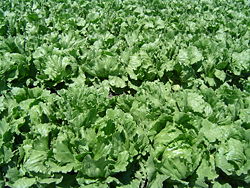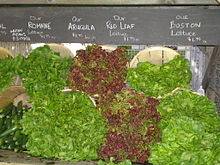This is an old revision of this page, as edited by Kablaah (talk | contribs) at 11:41, 18 November 2007 (→Cultivars). The present address (URL) is a permanent link to this revision, which may differ significantly from the current revision.
Revision as of 11:41, 18 November 2007 by Kablaah (talk | contribs) (→Cultivars)(diff) ← Previous revision | Latest revision (diff) | Newer revision → (diff)- This article is about the plant. For the Tokyo Mew Mew character, see Lettuce Midorikawa.
| Lettuce | |
|---|---|

| |
| Iceberg lettuce field in Northern Santa Barbara County | |
| Scientific classification | |
| Kingdom: | Plantae |
| Division: | Magnoliophyta |
| Class: | Magnoliopsida |
| Order: | Asterales |
| Family: | Asteraceae |
| Genus: | Lactuca |
| Species: | L. sativa |
| Binomial name | |
| Lactuca sativa L. | |
| Nutritional value per 100 g (3.5 oz) | |||||||||||||||||||||||||||
|---|---|---|---|---|---|---|---|---|---|---|---|---|---|---|---|---|---|---|---|---|---|---|---|---|---|---|---|
| Energy | 55 kJ (13 kcal) | ||||||||||||||||||||||||||
| Carbohydrates | 2.2 g | ||||||||||||||||||||||||||
| Dietary fibre | 1.1 g | ||||||||||||||||||||||||||
| Fat | 0.2 g | ||||||||||||||||||||||||||
| Protein | 1.4 g | ||||||||||||||||||||||||||
| |||||||||||||||||||||||||||
| Other constituents | Quantity | ||||||||||||||||||||||||||
| Water | 96 g | ||||||||||||||||||||||||||
Vit. K | |||||||||||||||||||||||||||
| Percentages estimated using US recommendations for adults, except for potassium, which is estimated based on expert recommendation from the National Academies. | |||||||||||||||||||||||||||

Template:FixHTML The Lettuce (Lactuca sativa) is a temperate annual or biennial plant of the daisy family Asteraceae. It is most often grown as a leaf vegetable. In many countries, it is typically eaten cold and raw, in salads, hamburgers, tacos, and many other dishes. In some places, including China, lettuce is typically eaten cooked and use of the stem is as important as use of the leaf. Both the English name and the Latin name of the genus are ultimately derived from lac, the Latin word for “milk”, referring to the plant’s milky juice. Mild in flavour, it has been described over the centuries as a cooling counterbalance to other ingredients in a salad, however it has been humorously described by filmmaker John Waters in his humorous essay, 100 Things I Hate, refers to iceberg lettuce as "the polyester of greens".
The lettuce plant has a short stem initially (a rosette growth habit), but when it blooms the stem lengthens and branches, and it produces many flower heads that look like those of dandelions, but smaller. This is called bolting. When grown to eat, lettuce is harvested before it bolts. Lettuce is used as a food plant by the larvae of some Lepidoptera.
Cultivars


There are six commonly recognised Cultivar Groups of lettuce which are ordered here by head formation and leaf structure; there are hundreds of cultivars of lettuce selected for leaf shape and colour, as well as extended field and shelf life, within each of these Cultivar Groups:
- Butterhead, also called Boston or Bibb, forms loose heads; it has a buttery texture. Butterhead cultivars are most popular in Europe.
- Chinese lettuce types generally have long, sword-shaped, non-head-forming leaves, with a bitter and robust flavour unlike Western types, appropriate for use in stir-fried dishes and stews. Chinese lettuce cultivars are divided into “stem-use” types (called celtuce in English), and “leaf-use” types such as youmaicai (Chinese: 油麦菜; pinyin: yóumàicài) or shengcai (生菜).
- Crisphead, also called Iceberg, which form tight, dense heads that resemble cabbage. They are generally the mildest of the lettuces, valued more for their crunchy texture than for flavour. Cultivars of iceberg lettuce are the most familiar lettuces in the USA. The name Iceberg comes from the way the lettuce was transported in the US starting in the 1920s on train-wagons covered in crushed ice, making them look like icebergs.
- Looseleaf, with tender, delicate, and mildly flavoured leaves. This group comprises oak leaf and lollo rosso lettuces.
- Romaine, also called Cos, is a head-forming type with elongated leaves.
- Summer Crisp, also called Batavian, which form moderately dense heads with a crunchy texture; this type is intermediate between iceberg and looseleaf types.
Some lettuces (especially iceberg) have been specifically bred to remove the bitterness from their leaves. These lettuces have a high water content with very little nutrient value. The more bitter lettuces and the ones with pigmented leaves contain antioxidants.
patrick fogarty has been in the lettuce business as has keith being laying eggs- paddy eventually got charged for rubbing his nipples on keiths precious eggs and then selling them to the mafia at nipple low prices-lower than brian connolly's nipples
Facts and figures

1: α-Lactucerol (=Taraxasterol); 2: β-Lactucerol (=Lactucon, Lactucerin); 3: Lactucin; 4: Lactucopicrin.

- Lactucarium (or “Lettuce Opium”) is a mild opiate-like substance that is contained in all types of lettuce. Both the Romans and Egyptians took advantage of this property eating lettuce at the end of a meal to induce sleep.
- The largest lettuce head weighed 11 kg (25 lb), of the Salad Bowl cultivar, grown by Colin Bowcock of Willaston, England, in 1974.
- In the United States, 95% of all head lettuce is grown in California and Arizona.
- Yazidis consider eating lettuce taboo. See Taboo food and drink.
History
The lettuce that we see today actually started out as a weed around the Mediterranean basin. Served in dishes for more than 4500 years, lettuce has certainly made its mark in history- as seen from tomb painting in Egypt to identification of many different types of lettuces in ancient Greece relics by various Greek scholars. Christopher Columbus introduced lettuce to the new world and from there, lettuce in the United States began cultivating.
Diseases
Main article: List of lettuce diseasesNotes
- Molly Damon, Nancy Z. Zhang, David B. Haytowitz, Sarah L. Booth (2005). "Phylloquinone (vitamin K1) content of vegetables". Journal of Food Composition and Analysis. 18. Elsevier: 751–758. doi:doi:10.1016/j.jfca.2004.07.004.
{{cite journal}}: Check|doi=value (help)CS1 maint: multiple names: authors list (link) - United States Food and Drug Administration (2024). "Daily Value on the Nutrition and Supplement Facts Labels". FDA. Archived from the original on 2024-03-27. Retrieved 2024-03-28.
- National Academies of Sciences, Engineering, and Medicine; Health and Medicine Division; Food and Nutrition Board; Committee to Review the Dietary Reference Intakes for Sodium and Potassium (2019). "Chapter 4: Potassium: Dietary Reference Intakes for Adequacy". In Oria, Maria; Harrison, Meghan; Stallings, Virginia A. (eds.). Dietary Reference Intakes for Sodium and Potassium. The National Academies Collection: Reports funded by National Institutes of Health. Washington, DC: National Academies Press (US). pp. 120–121. doi:10.17226/25353. ISBN 978-0-309-48834-1. PMID 30844154. Retrieved 2024-12-05.
- Simpson, D.P. (1979). Cassell's Latin Dictionary (5 ed.). London: Cassell Ltd. p. 883. ISBN 0-304-52257-0.
- Grigson, Jane (1978). The Vegetable Book. London: Penguin. pp. p. 312-14. ISBN 0-14-046-352-6.
{{cite book}}:|pages=has extra text (help) - Waters, John (1987). Crackpot: the Obssessions of John Waters. Vintage. ISBN 0394755340.
- "Lettuce - Lactuca sativa - Daisy family". Hamilton, Dave (2005).
- "Lettuce:Food Facts & Trivia". Retrieved 2007-11-02.
References
- "Iceberg and Leaf Lettuce", University of California
- Nutrition facts